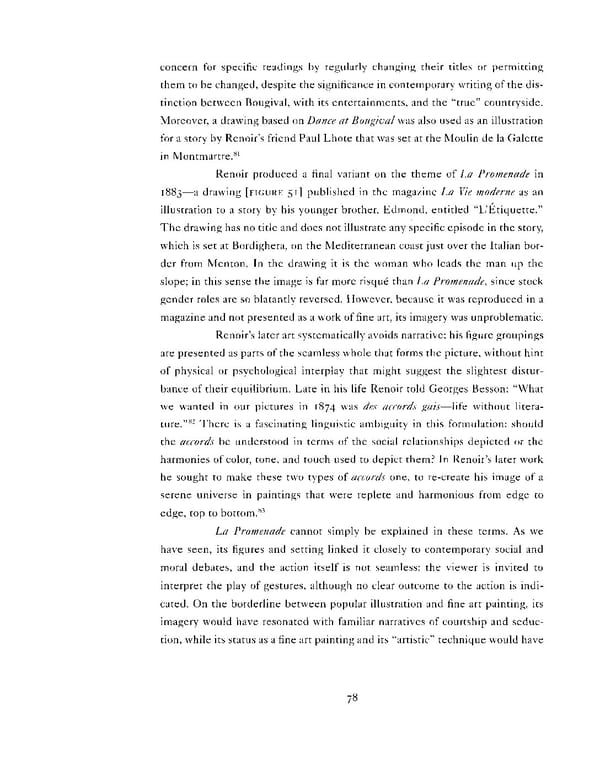concern for specific readings by regularly changing their titles or permitting them to be changed, despite the significance in contemporary writing of the dis- tinction between Bougival, with its entertainments, and the "true" countryside. Moreover, a drawing based on Dance at Bougival was also used as an illustration for a story by Renoir's friend Paul Lhote that was set at the Moulin de la Galette 81 in Montmartre. Renoir produced a final variant on the theme of La Promenade in 1883—a drawing [FIGURE 51] published in the magazine La Vie moderne as an illustration to a story by his younger brother, Edmond, entitled "L'Etiquette." The drawing has no title and does not illustrate any specific episode in the story, which is set at Bordighera, on the Mediterranean coast just over the Italian bor- der from Menton. In the drawing it is the woman who leads the man up the slope; in this sense the image is far more risque than La Promenade, since stock gender roles are so blatantly reversed. However, because it was reproduced in a magazine and not presented as a work of fine art, its imagery was unproblematic. Renoir's later art systematically avoids narrative; his figure groupings are presented as parts of the seamless whole that forms the picture, without hint of physical or psychological interplay that might suggest the slightest distur- bance of their equilibrium. Late in his life Renoir told Georges Besson: "What we wanted in our pictures in 1874 was des accords gais—life without litera- ture."82 There is a fascinating linguistic ambiguity in this formulation: should the accords be understood in terms of the social relationships depicted or the harmonies of color, tone, and touch used to depict them? In Renoir's later work he sought to make these two types of accords one, to re-create his image of a serene universe in paintings that were replete and harmonious from edge to 83 edge, top to bottom. La Promenade cannot simply be explained in these terms. As we have seen, its figures and setting linked it closely to contemporary social and moral debates, and the action itself is not seamless: the viewer is invited to interpret the play of gestures, although no clear outcome to the action is indi- cated. On the borderline between popular illustration and fine art painting, its imagery would have resonated with familiar narratives of courtship and seduc- tion, while its status as a fine art painting and its "artistic" technique would have 78
 Pierre-Auguste Renoir: La Promenade Page 85 Page 87
Pierre-Auguste Renoir: La Promenade Page 85 Page 87